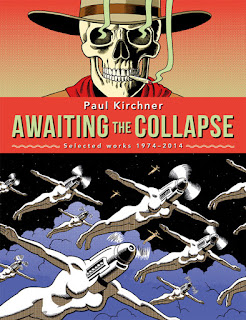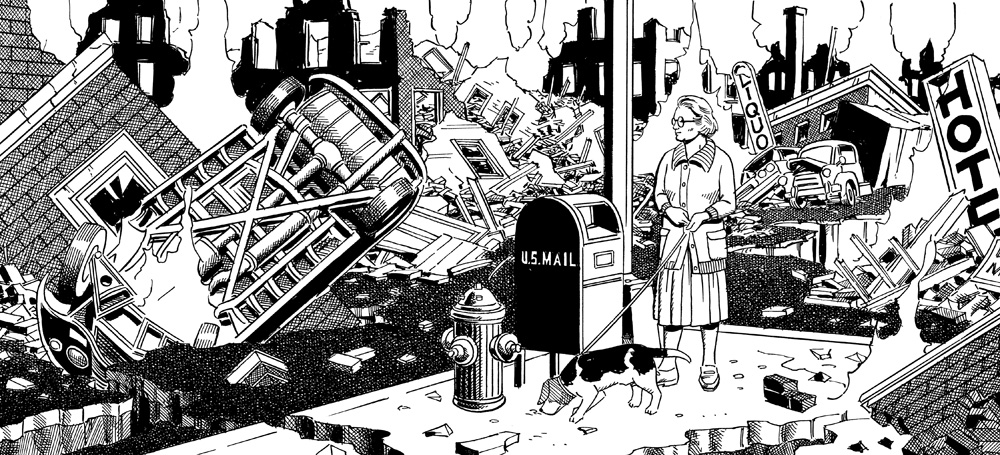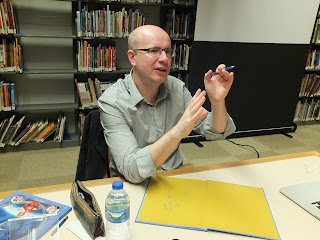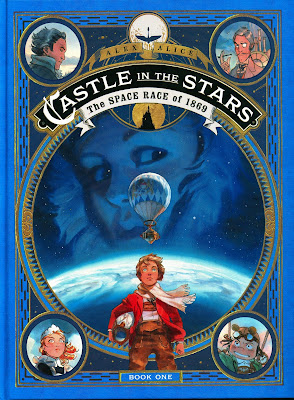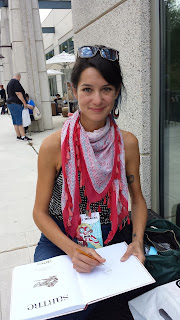by Katherine Collins*
Since the famous Louvre exhibit of Comics is cited so often, and was mentioned again in a lengthy press release from Heritage Auctions, I think the time has come for me to puff out my chest and reminisce about having been there, in Paris in 1967. (Yes, it was 1967, not 1968, as was mistakenly stated in HA's post.)
I am a Canadian, not any species of European. I happened to be in Paris in spring of 1967, just wrapping up a one-year "tour by bicycle" of Europe with my good friend Alan Hughes. We had split up for the day, to pursue separate interests. I was strolling along the Rue de Rivoli, in central Paris, not knowing that I was beside one of the walls of the rather enormous Palais du Louvre, and with no knowledge that there was an exhibit therein of (ta-da!) COMICS! Suddenly, I came upon a door into the Palais, with a lot of huge signs all around it, and up the high wall, proclaiming Bande Dessinée et Figuration Narrative — meaning Comic Strips and Graphic Narrative. (Luckily I could speak French a little bit.) The outside display also sported really enormous blow-ups of portions of panels from Hogarth's Tarzan, and Prince Valiant and Terry & The Pirates and lots more. I was utterly dumbstruck. It was like finding a gold mine! It was a gift from the gods! There was nothing in the world that I could have more happily come upon!
I had been digging for comics all over Europe for the previous year, and was fully aware of the European love of classic American comics — and of the many excellent reprints of the same, during the long period of drought of appreciation for those comics in North America. I was 19 years old, and had been very consciously and assiduously collecting everything to do with newspaper comics that I could find ever since I was nine years old, in the mid-50s. As anyone who was trying to do the same at that time can attest, there were very slim pickings. I had been buying every single available book of comics history and scholarship ever published, and I had maybe about five books. Plus my own scrapbooks, and my mother's scrapbooks of Caniff's Terry from the thirties and forties.
I was well aware of the energetic scorn consistently heaped upon comics by anybody who fancied themselves an arbiter of culture. I had been drawing my own comics since I was about 7, and publishing a strip in my University newspaper for the last two years. (And I went on to publish lots of comics for the next 21 years, and more again, more recently.) But I was never given any credit or praise for my work, alongside the others in my university "creative writing" community. If I had been writing puerile poetry and shallow short stories, I might have received some respect. But that did not happen. Nonetheless, I had no other ambition but in comics.
So, finding a comics exhibit, loudly trumpeted in The Louvre of all places, boosted my self-esteem and my belief in the worthiness of my interests. I have remained bolstered and proud ever since. Of course it was another twenty-five years, more or less, before genuine scholarship and quality reprinting of comics began to noticeably wriggle their way out of the Halls of Shame. I had to continue buying European reprints of American comics, in assorted languages, on buying trips to "The Continent." I would ship boxes of books home to myself.
I have never forgotten the joy and encouragement of that Louvre event. I have here beside me the "programme book," which is a 256-page, 8x11 very detailed history of, and love letter to, our favourite art form. Its bright-red covers have always shone proudly from my bookshelves ever since I brought it home in 1967. Maybe it is valuable, but I have never sought to find out. It is my treasure! It was translated into English in the early 70s or so, and of course I have that right beside me as well.
I lost track of the hours I spent inside the exhibit on that day. What sticks in my memory the strongest is the huge — really huge! — enlargements of individual panels of all the great strips from throughout comics history. You name them, there they were. Their size recalibrated my standards of appreciation for comics. Before then, I had seen only, at the biggest, panels of maybe 6x8 inches. These were up to 6 ft. by 8 ft.! Maybe bigger. Ever since then, I have always preferred my comics really big!!
And the lengthy texts posted on the walls gave an intelligent voice to the analysis and appreciation of the comics; this was something I had been lacking for my whole life. Although I have, in the subsequent 53 years, forgotten a lot of the details of the show, I can still easily call back to my mind and emotions the astonished excitement of being there, surrounded by huge comics and the obvious respect they were given. My heart once again beats faster, my mind reels with mounting pleasure, and I am once again distracted from any other reality in the world. I can feel it again any time I want.
In late afternoon, I stumbled back out onto the street, clutching my programme book of inestimable value, thinking of nothing but comics; I was unconscious even of the charms of my favourite city, Paris. And you can tell by this paean to the exhibit and its comics, that I have never lost the thrill and the re-education of the Louvre's history-making creation.
*I was the cartoonist of "Neil the Horse," which was part of the black-and-white boom in the 1980s, under my former name, Arn Saba. A big fat anthology (360 pp.) was published in 2017, by Conundrum Press; it was titled "The Collected Neil the Horse." My name change was due to a "sex change", as they formerly were called. It was "announced" in 1993, and resulted in my immediate expulsion from the comics community. I could not get published again until 2017, with the anthology. I am now working on a new graphic novel for Conundrum. It is not a funny animal book this time, but a "real people in the real world" story. Not to be melodramatic, but I may not live to finish it. My health is very dire and uneven. I have long periods of complete disability. Many doctors have failed to diagnose it, over the last five years. But I am plugging along as much as possible. I am happy to say that I am thrilled to be Back In Business as a cartoonist. I owe fulsome thanks for this pleasure to Andy Brown, the Honcho of Conundrum Press, and one of the finest gentlemen I have ever known.
(UPDATED Sept 21 2020):
I try never to miss an opportunity to plug myself. So I should also mention that I have been inducted into both of Canada's "Comics Halls of Fame". (I don't know why Canada has two.) I was named to The Joe Shuster Awards in 2013; and in 2017 was entered into The Giants of the North Canadian Cartooning Hall of Fame.
One last toot of the horn: the graphic novel I'm working on has the Working Title of "Beautiful". Nice and simple, but could be changed in time. It takes place in Vancouver in 1918, during the so-called Spanish Flu epidemic. I have been planning this book for decades, and its timing, at the outbreak of the Covid-19, is a coincidence. I am not sure whether I think this is a good thing or not. The story is deeply-researched, but is not really "about" the flu epidemic. It is "about" the main characters living through the drama of so much death. Large pages, beautiful scenery, good looks at early Vancouver. It is another "big fat" book, and I hope it will be in colour. It is also a sapphic love story, and what's more involves some Native characters, who have fled up the coast. I have had to constantly pull the reins on myself so that I don't keep writing in all sorts of slapstick and nonsense. (That being my natural tendency.) It is a serious story, but not grim or horrible. There's also some political content, about the left-wing resistance to Canada's WWI conscription, and the simultaneous fierce anti-union stance of the government. One of main characters is an activist.















